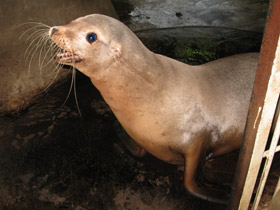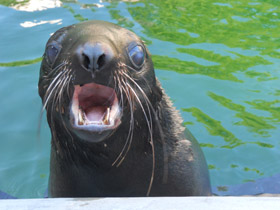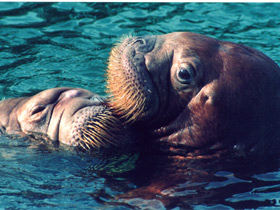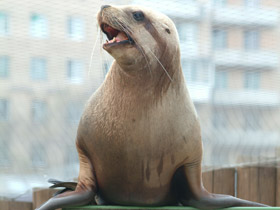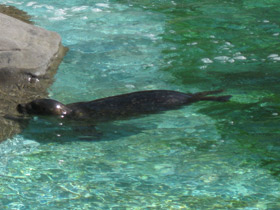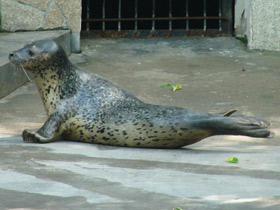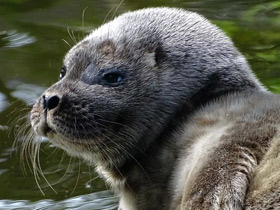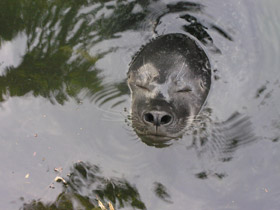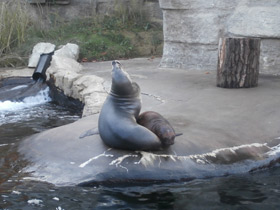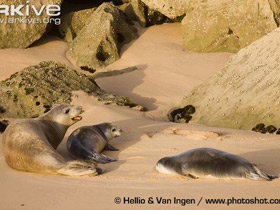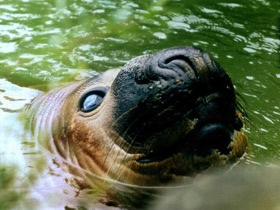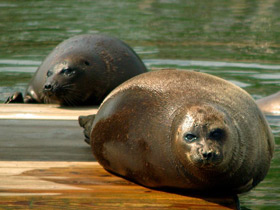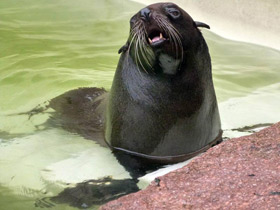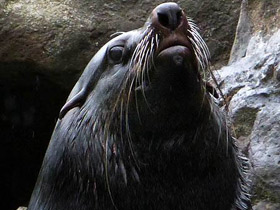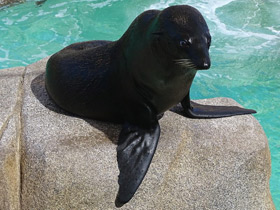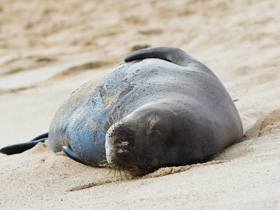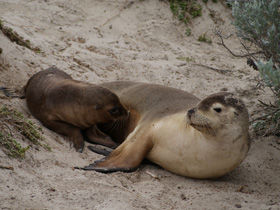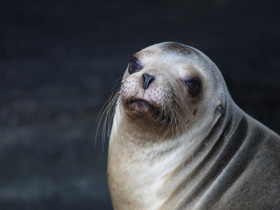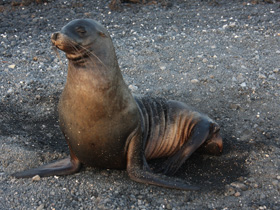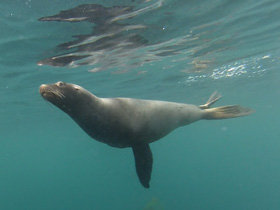Pinnipeds or seals (Pinnipedia)
Phylogenetic Tree of Pinnipeds
(Callorhinus, Arctocephalus)
Otaria, Neophoca, Phocarctos)
Phoca, Histriophoca,
Halichoerus)
Ommatophoca, Lobodon, Hydrurga)
Pinnipeds (pronounced /ˈpɪnɪˌpɛdz/), commonly known as seals, are a widely distributed and diverse clade of carnivorous, fin-footed, semi-aquatic, mostly marine mammals. They comprise the extant families Odobenidae (whose only living member is the walrus), Otariidae (the eared seals: sea lions and fur seals), and Phocidae (the earless seals, or true seals), with 34 extant species and more than 50 extinct species described from fossils. While seals were historically thought to have descended from two ancestral lines, molecular evidence supports them as a monophyletic lineage (descended from one ancestral line). Pinnipeds belong to the clade Caniformia of the order Carnivora; their closest living relatives are musteloids (weasels, raccoons, skunks and red pandas), having diverged about 50 million years ago.
Seals range in size from the 1 m (3 ft 3 in) and 45 kg (99 lb) Baikal seal to the 5 m (16 ft) and 3,200 kg (7,100 lb) southern elephant seal male. Several species exhibit sexual dimorphism. They have streamlined bodies and four limbs that are modified into flippers. Though not as fast in the water as dolphins, seals are more flexible and agile. Otariids use their front limbs primarily to propel themselves through the water, while phocids and walruses use their hind limbs. Otariids and walruses have hind limbs that can be pulled under the body and used as legs on land. By comparison, terrestrial locomotion by phocids is more cumbersome. Otariids have visible external ears, while phocids and walruses lack these. Pinnipeds have well-developed senses—their eyesight and hearing are adapted for both air and water, and they have an advanced tactile system in their whiskers or vibrissae. Some species are well adapted for diving to great depths. They have a layer of fat, or blubber, under the skin to keep warm in the cold water, and, other than the walrus, all species are covered in fur.
Although pinnipeds are widespread, most species prefer the colder waters of the Northern and Southern Hemispheres. They spend most of their lives in the water, but come ashore to mate, give birth, molt or escape from predators, such as sharks and orcas. Seals mainly live in marine environments but can also be found in freshwater. They feed largely on fish and marine invertebrates; a few, such as the leopard seal, feed on large vertebrates, such as penguins and other seals. Walruses are specialized for feeding on bottom-dwelling mollusks. Male pinnipeds typically mate with more than one female (polygyny), although the degree of polygyny varies with the species. The males of land-breeding species tend to mate with a greater number of females than those of ice breeding species. Male pinniped strategies for reproductive success vary between defending females, defending territories that attract females and performing ritual displays or lek mating. Pups are typically born in the spring and summer months and females bear almost all the responsibility for raising them. Mothers of some species fast and nurse their young for a relatively short period of time while others take foraging trips at sea between nursing bouts. Walruses are known to nurse their young while at sea. Seals produce a number of vocalizations, notably the barks of California sea lions, the gong-like calls of walruses and the complex songs of Weddell seals.
The meat, blubber and fur coats of pinnipeds have traditionally been used by indigenous peoples of the Arctic. Seals have been depicted in various cultures worldwide. They are commonly kept in captivity and are even sometimes trained to perform tricks and tasks. Once relentlessly hunted by commercial industries for their products, seals and walruses are now protected by international law. The Japanese sea lion and the Caribbean monk seal have become extinct in the past century, while the Mediterranean monk seal and Hawaiian monk seal are ranked endangered by the International Union for Conservation of Nature. Besides hunting, pinnipeds also face threats from accidental trapping, marine pollution, climate change and conflicts with local people.
Diversity of pinnipeds
Pinnipeds include the families of walrus (Odobenidae, with a single species), harbour seals (Otariidae) and harbour seals (Phocidae).Representatives of harbour seals (Otariidae) are harbour seals and sea lions, with a total of 12 species from 6 genera.Harbour seals (Phocidae) include harbour seals, harbour seals, harbour seals, sea leopards, crab seals and elephant seals, with a total of 19 species from 13 genera.
Etymology
The name "pinniped" derives from the Latin words pinna "fin" and pes, pedis "foot". The common name "seal" originates from the Old English word seolh, which is in turn derived from the Proto-Germanic *selkhaz.
Taxonomy
The German naturalist Johann Karl Wilhelm Illiger was the first to recognize the pinnipeds as a distinct taxonomic unit; in 1811 he gave the name Pinnipedia to both a family and an order. American zoologist Joel Asaph Allen reviewed the world's pinnipeds in an 1880 monograph, History of North American pinnipeds, a monograph of the walruses, sea-lions, sea-bears and seals of North America. In this publication, he traced the history of names, gave keys to families and genera, described North American species and provided synopses of species in other parts of the world. In 1989, Annalisa Berta and colleagues proposed the unranked clade Pinnipedimorpha to contain the fossil genus Enaliarctos and modern seals as a sister group. Pinnipeds belong to the order Carnivora and the suborder Caniformia (known as dog-like carnivorans). Of the three extant families, the Otariidae and Odobenidae are grouped in the superfamily Otarioidea, while the Phocidae belong to the superfamily Phocoidea. There are 34 extant species of pinnipeds, and more than 50 fossil species.
Otariids are also known as eared seals due to the presence of pinnae. These animals swim mainly using their well-developed fore-flippers. They can also "walk" on land by shifting their hind-flippers forward under the body. The front end of an otariid's frontal bone protrudes between the nasal bones, with a large and flattened supraorbital foramen. An extra spine spliting the supraspinatous fossa and bronchi that are divided in the front. Otariids consist of two types: sea lions and fur seals; the latter typically being smaller in size with pointier snouts, longer fore-flippers and heavier fur coats that include an undercoat and guard hairs. Five genera and seven species (one now extinct) of sea lion are known to exist, while two genera and nine species of fur seal exist. While sea lions and fur seals have historically been considered separate subfamilies (Otariinae and Arctocephalinae respectively), genetic and molecular have refuted this, finding that the northern fur seal is basal and the Australian sea lion and New Zealand sea lion are more closely related to Arctocephalus than to other sea lions.
Odobenidae consists of only one living member: the modern walrus. This animal noticeable by its larger size (exceeded only by the elephant seals), nearly hairless skin, flattened snout and long upper canines, known as tusks. Like otariids, walruses are capable of walking on land with their hind-flippers. When moving in water, the walrus relies on its hind-flippers for locomotion, while its fore-flippers are used for steering. In addition, visible ear flap are not present in the species. The epipterygoid of the jaw is well developed and the back of the nasal bones are horizontal. In the feet, the calcaneuses protrude in the middle.
Phocids are known as true or "earless" seals. These animals lack external ear flaps and are incapable of positioning their hind-flippers to move on land, making them more cumbersome. In water, true seals rely on the side-to-side motion of their hind-flippers and lower body to move forward. This is because of their massive ankle bones and flatter heel. The phocids skull has thickened mastoids, puffed up entotympanic bones, nasal bones with a pointed tip in the back and a non-existent supraorbital foramen. The hip has a more converse ilia. A 2006 molecular study supports the division of phocids into two monophyletic subfamilies: Monachinae, which consists of Mirounga, Monachini and Lobodontini; and Phocinae, which includes Pusa, Phoca, Halichoerus, Histriophoca, Pagophilus, Erignathus and Cystophora.
Locomotion
Pinnipeds have two pairs of flippers on the front and back, the fore-flippers and hind-flippers. Their elbows and ankles are not externally visible. Pinnipeds are not as fast as cetaceans, typically swimming at 5–15 kn (9–28 km/h; 6–17 mph) compared to around 20 kn (37 km/h; 23 mph) for several species of dolphin. Seals are more agile and flexible, and some otariids, such as the California sea lion, can make dorsal as their heads can touch their hind flippers due to a flexible spines. Pinnipeds have several adaptions for reducing drag. In addition to their streamlined bodies, they have smooth networks of muscle bundles in their skin that may increase laminar flow and cut through the water. The hair erector muscles are absent, so their fur can be streamlined as they swim.
Thermoregulation
Pinnipeds keep warm by having large, thick bodies, insulating blubber and fur, and quick-burning metabolism. In addition, the blood vessels in their flippers are adapted for countercurrent exchange; where warm blood circulates from the body core through an artery to the flippers, where the cold blood in the veins warms up and is transported back to the core. While blubber and fur keep the seal warm in water, they can also overheat the animal when it is on land. To counteract overheating, many species cool off by covering themselves in sand. Monk seals may even dig up the cooler layers. The northern fur seal cools off by panting.
Sleep
Pinnipeds spend many months at a time at sea, so they must sleep in the water. Scientists have recorded them sleeping for minutes at a time while slowly drifting downward in a belly-up orientation. Like other marine mammals, seals sleep in water with half of their brain awake so that they can detect and escape from predators, as well as surface for air without fully waking. When they are asleep on land, both sides of their brain go into sleep mode.
Distribution and habitat
Living pinnipeds are widespread in cold oceanic waters; particularly in North Atlantic, the North Pacific and the Southern Ocean. By contrast, the consistently warm Indomalayan waters have no seals. Monk seals and some otariids live in tropical and subtropical waters. Seals usually require cool, nutrient-rich waters with temperatures lower than 20 °C (68 °F). Even in more tropical climates, pinnipeds may live in waters with currents that make then colder and more nutrient-rich. Only monk seals live in waters that are not typically cool or nutrient-rich. The Caspian seal and Baikal seal are found in large landlocked bodies of water (the Caspian Sea and Lake Baikal respectively).
As a whole, pinnipeds can be found in a variety of aquatic habitats, mostly coastal water, but also open ocean, deep waters near offshore islands, brackish waters and even freshwater lakes and rivers. The Baikal seal is the only exclusively freshwater species. Pinnipeds also use a number of terrestrial habitats and substrates, both continental and island. In non-polar regions, they haul out on to rocky shores, sandy and pebble beaches, sandbanks, tidal flats or pools, and in sea caves. Some species also rest on man-made structures built along the coast or offshore. Pinnipeds may move further from the water using sand dunes or vegetation, or even rocky cliffs. New Zealand sea lions are the only pinniped that can be found up to 2 kilometres (1.2 mi) inland in forests. In polar regions, seals haul out on to both fast ice and drift ice. Some even den underneath the ice, particularly in pressure ridges and crevasses.
Behavior and life history
Pinnipeds have an amphibious lifestyle; they are mostly aquatic, but haul out to breed, molt, rest, sun or to avoid aquatic predators. Several species are known to migrate over vast distances, particularly in response to environmental changes. Elephant seals are at sea for most of the year and there are vast distances between their breeding and molting sites. The northern elephant seal is one of farthest mammalian migraters, traveling 18,000–21,000 km (11,000–13,000 mi). Otariids tend to migrate less than phocids, especially tropical species. Traveling seals may reach their destination using geomagnetic fields, water and wind currents, solar and lunar positions and the temperature and chemical makeup of the water.
Pinnipeds may dive during foraging or to avoid predators. When foraging, for example, the Weddell seal typically dives no for more then 15 minutes and 400 m (1,300 ft) deep, but can dive for as long as 73 minutes and reach 600 m (2,000 ft) deep. Northern elephant seals often dive 350–650 m (1,150–2,130 ft) for as long as 20 minutes. They can also dive 1,500 m (4,900 ft) and for over an hour. The dives of otariids tend to be shorter and less deep. They typically last 5–7 minutes with average depths to 30–45 m (98–148 ft). However, the New Zealand sea lion has been recorded diving to a maximum of 460 m (1,510 ft) and have submerged for as long as 12 minutes. The diet of walruses does not require them to dive very deep or very long. Pinnipeds generally live 25–30 years.
Reproductive behavior
The mating system of pinnipeds varies from extreme polygyny to serial monogamy. Of the 33 species, 20 breed on land, and the remaining 13 breed on ice.
Birth and parenting
With the exception of the walrus, which have five- to six-year gaps between births, female pinnipeds enter estrous shortly after they give birth and can thus produce pups every year. All species go through delayed implantation, wherein the embryo does not enter the uterus for weeks or months. Delayed implantation allows to female to wait until conditions are right for birthing. Gestation in seals (including delayed implantation) typically lasts a year. For most species, birthing takes place in spring and summer. Typically, single pups are born; twins are uncommon and have high mortality rates. Pups of most species are born relatively developed and precocial. Pinniped milk has "little to no lactose".
In captivity
Pinnipeds can be found in facilities around the world, as their size and playfulness make them popular attractions. Seals have been kept in captivity since at least Ancient Rome and their trainability was noticed by Pliny the Elder. Zoologist Georges Cuvier noted during the 19th century that wild seals show considerable affection for humans and stated that they are second only to some monkeys among wild animals in their easy tamability. Francis Galton noted in his seminal work on domestication that seals were a spectacular example of an animal that would most likely never be domesticated despite their friendliness, survivability and "desire for comfort" due to the fact that they serve no practical use for humans.

















